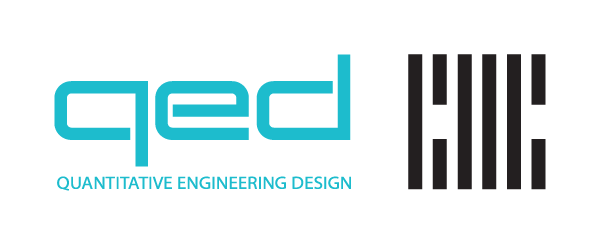
Story of our logo
Our name, QED (Quantitative Engineering Design), is a play on the Latin phrase quod erat demonstrandum, which translates to “that which was to be demonstrated.“ Mathematicians and philosophers dating from antiquity through the Renaissance would write this phrase at the end of written arguments, to indicate they had successfully proven what they set out to prove. This is the end-state we wish to achieve when solving meaningful problems.
The written representation of this concept has evolved over time. Initially it was written out fully, as shown in Euclid’s Elements. Later it was abbreviated as “Q.E.D.”, as illustrated in Spinoza’s Ethics. Today, in modern mathematical papers typeset with Knuth’s LaTeX, this initialism is further abbreviated as simply a square (Unicode U+25A2): ▢.
Our Logo
Following this theme, our logo is also shaped like a square. The style of the square comes from the I Ching (易经), or “Book of Changes”.
The I Ching is the oldest of the Chinese classics, dating back to 1000 BC. Originally it was used as an oracle by kings to predict the future. Over time, it became a general guide for moral decision making, used to organize governments, root out corruption, and provide the foundations of Confucianism, Taoism, and Tai Chi.
The core of the I Ching lies in its system of hexagrams, which consists of six horizontal bars stacked together, each of which can be either open (Yin) or closed (Yang). By varying the pattern of open and closed, sixty-four different hexagrams can be created, as illustrated below in their original ordering. Each hexagram is associated with a different phenomenon, such as #46: 升 (Pushing Upward / Ascending), or #7: 师 (The Army / Leading).
During the Song dynasty, a philosopher named Shao Yong (邵雍, 1011–1077 AD) provided a novel reordering of these hexagrams, as shown below.
This arrangement should look familiar to anyone involved with computation or mathematics … it is the binary number system! By interpreting Yin as 0 and Yang as 1, every hexagram is mapped to a 6-bit integer, between 0 and 63 inclusive. In fact, the I Ching provided Leibniz with the inspiration to bring binary to the West.
Another figure in Chinese history, King Wen of Zhou
(周文王, 1099–1050 BC), observed that by flipping a hexagram upside down, we can generate another hexagram that is referred to as its dual. Consequently, by drawing vertical strikes rather than horizontal ones, King Wen compressed 64 hexagrams into 32 dualities.
The duality we chose for our logo is the following
OPEN
FIRE
Abolish the old
rotate -90°
rotate 90°
FIRE
WIND
Establish the new
The Message
Putting the hexagrams together, this is the message embedded within:
to abolish the old and establish the new.
All people search for constants to rely on, only to eventually discover that there are none. In both the East and the West, our ancestors knew this, and advised their posterity to embrace uncertainty and explore the unknown.
The only thing that is constant is change.
Heraclitus











